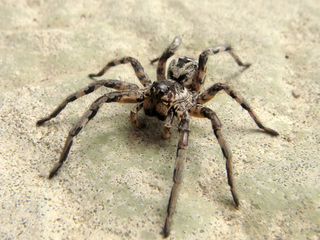
Wolf spiders are members of the family Lycosidae, named for their robust and agile hunting skills and excellent eyesight. They live mostly in solitude, hunt alone, and usually do not spin webs. Some are opportunistic hunters, pouncing upon prey as they find it or chasing it over short distances; others wait for passing prey in or near the mouth of a burrow. Wolf spiders resemble nursery web spiders, but wolf spiders carry their egg sacs by attaching them to their spinnerets, while the Pisauridae carry their egg sacs with their chelicerae and pedipalps. Two of the wolf spider's eight eyes are large and prominent; this distinguishes them from nursery web spiders, whose eyes are all of roughly equal size. This can also help distinguish them from the similar-looking grass spiders.

Lycosa tarantula is the species originally known as the tarantula, a name that nowadays in English commonly refers to spiders in another family entirely, the Theraphosidae. It now may be better called the tarantula wolf spider, being in the wolf spider family, the Lycosidae. L. tarantula is a large species found in southern Europe, especially in the Apulia region of Italy and near the city of Taranto, from which it gets its name.
Auloniella is a genus of spiders in the family Lycosidae. It was first described in 1960 by Roewer. As of 2017, it contains only one species, Auloniella maculisterna, found in Tanzania.
Bristowiella is a genus of spiders in the family Lycosidae. It was first described in 1980 by Saaristo. As of 2017, it contains 2 species.
Crocodilosa is a genus of spiders in the family Lycosidae. It was first described in 1947 by Caporiacco. As of 2017, it contains 5 species.
Dolocosa is a genus of spiders in the family Lycosidae. It was first described in 1960 by Roewer. As of 2017, it contains only one species, Dolocosa dolosa, on the island of Saint Helena.
Donacosa is a genus of spiders in the family Lycosidae. It was first described in 1991 by Alderweireldt & Jocqué. As of 2017, it contains only one species, Donacosa merlini, found in Spain.
Edenticosa is a genus of spiders in the family Lycosidae. It was first described in 1960 by Roewer. As of 2017, it contains only one species, Edenticosa edentula, on the island of Bioko.
Gnatholycosa is a genus of spiders in the family Lycosidae. It was first described in 1940 by Mello-Leitão. As of 2017, it contains only one species, Gnatholycosa spinipalpis, found in Argentina.
Hognoides is a genus of spiders in the family Lycosidae. It was first described in 1960 by Roewer. As of 2017, it contains 2 species.
Hyaenosa is a genus of spiders in the family Lycosidae. It was first described in 1940 by Caporiacco. As of 2017, it contains 5 species.
Loculla is a genus of spiders in the family Lycosidae. It was first described in 1910 by Simon. As of 2017, it contains 5 species.
Mainosa is a genus of spiders in the family Lycosidae. It was first described in 2006 by Framenau. As of 2017, it contains only one species, Mainosa longipes, found in Australia.
Margonia is a genus of spiders in the family Lycosidae. It was first described in 1983 by Hippa & Lehtinen. As of 2017, it contains only one species, Margonia himalayensis, found in India.
Melocosa is a genus of spiders in the family Lycosidae. It was first described in 1937 by Gertsch. As of 2017, it contains 2 species.
Mustelicosa is a genus of spiders in the family Lycosidae. It was first described in 1960 by Roewer. As of 2017, it contains 2 species.
Paratrochosina is a genus of spiders in the family Lycosidae. It was first described in 1960 by Roewer. As of 2017, it contains 3 species.
Syroloma is a genus of spiders in the family Lycosidae. It was first described in 1900 by Simon. As of 2017, it contains two species from Hawaii.

Tetralycosa is a genus of Australian spiders in the family Lycosidae first described by Roewer in 1960, later revised by Framenau & Hudson to include thirteen species. Genetic studies show that these spiders all diverged from a common ancestor who likely wandered into the salty area and remained. They live exclusively in certain saline environments of Australia's interior, including coastal beaches, mound springs, clay pans, and salt lakes. There haven't been enough studies to establish a conservation status, but some species have only been found in solitary salt lakes, suggesting that the increase of mining, agriculture, recreational, and similar disturbances of these unique ecosystems may eventually lead to their extinction if not properly regulated.
Tricassa is a genus of spiders in the family Lycosidae. It was first described in 1910 by Simon. As of 2017, it contains 2 African species.


